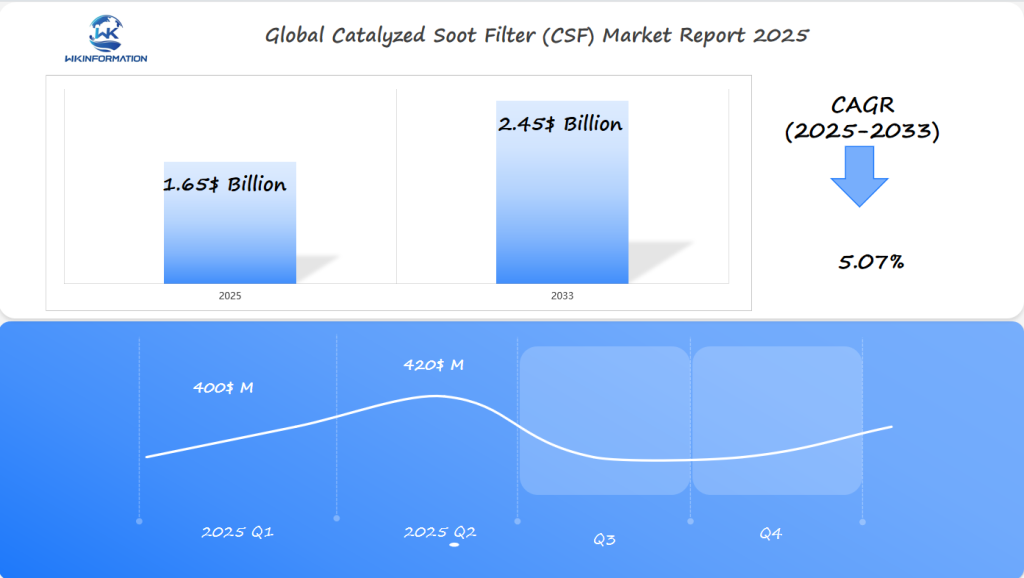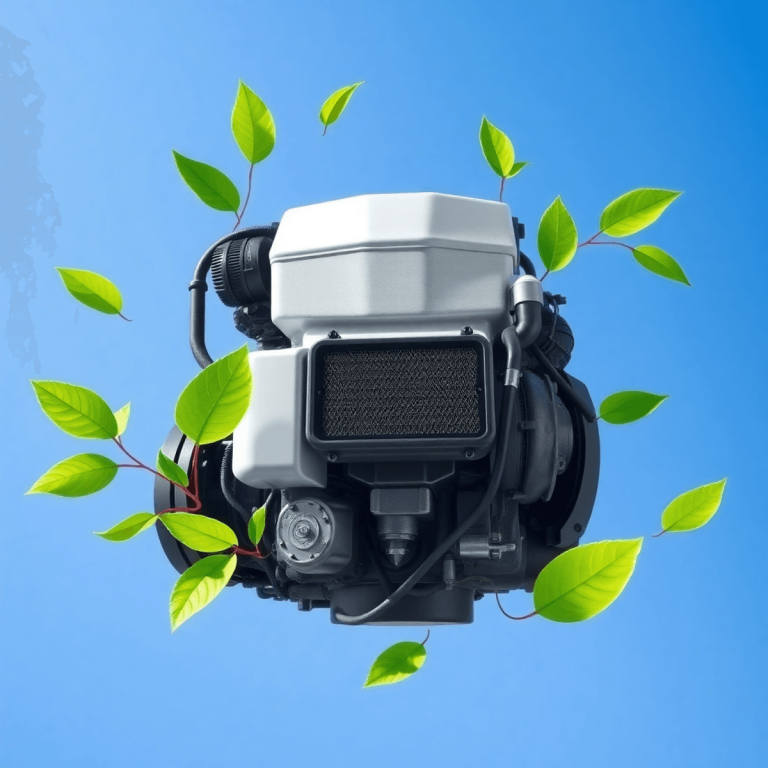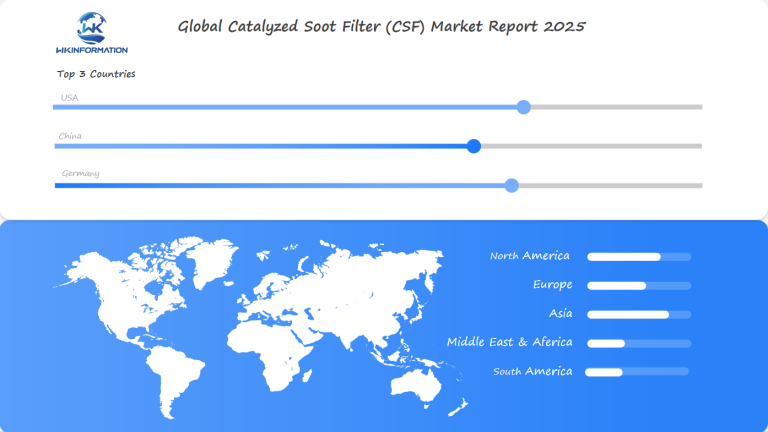2025 Catalyzed Soot Filter (CSF) Market Trends: USA, China, and Germany Paving the Way Worth $1.65 Billion
Catalyzed Soot Filter (CSF) Market will reach USD 1.65 Billion in 2025 and is expected to reach USD 2.45 Billion in 2033, with a CAGR of 5.07% from 2025 to 2033, highlighting its potential as a key growth market.
- Last Updated:
Projected Market Insights for Catalyzed Soot Filter (CSF) in Q1 and Q2 of 2025
The Catalyzed Soot Filter (CSF) market is projected to reach $1.65 billion in 2025, growing at a CAGR of 5.07% from 2025 to 2033. In Q1, the market is expected to be valued at around $400 million, driven by stricter environmental regulations and the increasing demand for emission control solutions. By Q2, the market is anticipated to expand to approximately $420 million, continuing its upward trajectory.
The USA, China, and Germany will be the leading markets for CSFs, with China’s growing automotive and industrial sectors, Germany’s strong automotive manufacturing base, and the USA’s emphasis on environmental sustainability. Increasing investments in green technologies and cleaner emissions systems will further accelerate growth in these regions.

Factors Influencing the Catalyzed Soot Filter (CSF) Market
To understand the Catalyzed Soot Filter market, we need to closely look at both upstream and downstream factors. These factors play a crucial role in determining how CSF is produced and accepted in the industry.
Upstream Factors
- Raw Material Availability: The supply chain for raw materials, such as precious metals used in catalysis, is a critical component. Fluctuations in availability and pricing can impact production costs and influence market stability.
- Technological Advancements: Innovations in materials science contribute to more efficient filtering solutions. These advancements reduce dependency on scarce resources, fostering sustainable growth.
Downstream Factors
- Regulatory Pressures: Stringent emission standards are crucial in driving demand for CSFs. In regions like the USA, China, and Germany, regulatory bodies enforce strict compliance, pushing manufacturers towards advanced filtration technologies.
- Customer Demand: A growing awareness of environmental issues has increased consumer demand for cleaner technologies. This shift encourages vehicle manufacturers to incorporate cutting-edge CSFs to meet consumer expectations and regulatory requirements.
These factors work together to shape the growth of the CSF market, affecting production capabilities and adoption rates in various industries. By understanding these elements, we gain insight into how the industry adapts to changing circumstances and technological advancements.
Key Trends Shaping the Future of the Catalyzed Soot Filter (CSF) Market in 2025
Emerging technologies are playing a crucial role in shaping the future of the Catalyzed Soot Filter (CSF) market. Innovations in filtration technology advancements have led to the development of more efficient and durable CSFs, which are essential for meeting evolving emission standards. These advancements include the introduction of nanotechnology in filter coatings and the use of advanced ceramic materials that enhance filtration efficiency and longevity.
Regulatory changes are another driving force impacting market dynamics. Stricter emission standards in key regions like the USA, China, and Germany necessitate advanced CSF solutions. In the USA, legislation such as the National Ambient Air Quality Standards is pushing manufacturers toward adopting cutting-edge technologies. Similarly, China’s regulatory landscape is evolving rapidly, with new rules being implemented to tackle air pollution effectively. Germany’s stringent Euro standards also compel automotive manufacturers to integrate high-performance CSFs into their vehicles.
These trends indicate a strong growth trajectory for the CSF market as industry players strive to innovate and comply with regulatory demands. The combination of technological advancements and regulatory pressures highlights a promising future for the CSF industry by 2025.
Restrictions and Challenges Facing the Catalyzed Soot Filter (CSF) Market
The Catalyzed Soot Filter (CSF) market faces notable challenges, primarily driven by strict emission regulations. These regulations, while essential for environmental protection, present significant obstacles for manufacturers seeking to innovate and expand.
Limited Design Flexibility
One of the main challenges is the limited design flexibilitythat manufacturers encounter. Stringent standards often require adherence to specific design criteria, constraining innovation in filter development.
Technological Challenges
Technological challenges make the situation even more complicated. It’s still very difficult to achieve the best durability and filter regeneration efficiency. Filters have to endure tough weather conditions and regular temperature changes, which require strong materials and innovative engineering solutions.
Balancing Compliance and Innovation
Manufacturers have the responsibility of creating Critical Success Factors (CSFs) that not only comply with regulations but also provide long-lasting reliability and effectiveness. This delicate balance between following rules and being innovative is what characterizes the industry today. It requires continuous progress to overcome these challenges in a meaningful way. Part of this progress involves tracking key performance indicators, such as cybersecurity metrics, which are essential for maintaining compliance while fostering innovation.

Geopolitical Implications for the Catalyzed Soot Filter (CSF) Industry
Geopolitical factors play a crucial role in shaping the Catalyzed Soot Filter (CSF) industry, particularly through international regulations. The Paris Agreement is a significant global policy that influences the adoption rates of CSFs by requiring countries to commit to reducing particulate matter emissions from vehicles and industrial sources.
Key Geopolitical Factors Influencing the CSF Industry
- Paris Agreement: This landmark accord compels nations to undertake rigorous environmental strategies, thereby driving the demand for efficient emission control technologies like CSFs. It fosters a collaborative approach among countries to curb air pollution, aligning with national policies that promote cleaner automotive and industrial practices.
- Commitment to Emission Reduction: Countries such as the USA, China, and Germany have reinforced their stance on minimizing emissions through stringent local mandates. These nations target substantial reductions in particulate matter, fueling the necessity for advanced filtration solutions.
- Industrial Sources and Vehicle Regulations: With industries being major contributors to pollution, global policies encourage innovation in emission control technologies across various sectors. The push for cleaner transportation systems underlines the importance of CSFs in maintaining compliance with evolving international standards.
In line with these geopolitical trends, manufacturers and policymakers continue to prioritize sustainable development and environmental stewardship through enhanced CSF integration. This focus ensures ongoing investment in cutting-edge filtration technologies that meet both regulatory requirements and market demands.
Types of Catalyzed Soot Filters and Their Applications in Emission Control
Catalyzed soot filters (CSFs) are crucial in reducing emissions, with different types designed for specific applications. Wall-flow filters are a popular choice because they efficiently trap particulate matter. These filters operate by directing exhaust gases through porous walls, capturing soot particles while allowing clean gas to pass through.
Another important type is the coated cordierite substrate, which combines the benefits of ceramic materials with catalytic properties. This type improves the oxidation of soot, leading to cleaner emissions. Cordierite is particularly preferred for its ability to withstand high temperatures and cost-effectiveness.
Applications of CSFs can be found in various industries, mainly driven by the need for effective emission control:
- Automotive exhaust systems: Vehicles with diesel engines benefit from CSFs’ capability to significantly reduce particulate emissions, meeting strict regulatory standards.
- Stationary power generation units: Industrial plants and power stations use CSFs to minimize pollutants released into the air during fuel combustion processes.
The flexibility and adaptability of different CSF types highlight their significance in achieving environmental compliance across industries. As global emission standards become stricter, the demand for advanced CSF technologies continues to grow, highlighting their essential role in sustainable practices.
Applications of Catalyzed Soot Filters in Automotive and Industrial Sectors
Catalyzed soot filters (CSFs) play a crucial role in reducing particulate emissions from diesel engines, making them essential in both automotive and industrial applications.
Automotive Applications
In the automotive sector, CSFs are widely used in:
- Passenger cars
- Commercial vehicles
- Heavy-duty trucks
These filters help minimize soot accumulation, improve fuel efficiency, and enhance engine performance by enabling efficient regeneration processes. They are designed to comply with stringent emission standards such as Euro 6, China VI, and EPA regulations.
Industrial Applications
Beyond automotive applications, CSFs are increasingly adopted in industrial sectors, including:
- Construction
- Mining
- Marine transportation
Heavy machinery and equipment operating in emission-sensitive environments rely on CSFs to meet environmental regulations while maintaining operational efficiency. Additionally, industrial generators and stationary diesel engines utilize CSFs to control air pollution, supporting sustainability initiatives in manufacturing and energy production.
As emission standards continue to tighten, advancements in CSF technology will further drive adoption across various industries.
Global Market Overview of Catalyzed Soot Filters and Regional Insights
The global catalyzed soot filter (CSF) market is experiencing significant growth, driven by strict emission regulations, increasing use of diesel particulate filters (DPFs), and advancements in catalyst technologies. As governments worldwide tighten emission standards, demand for CSFs is rising across various industries, particularly in the automotive and industrial sectors.
Key players in the market are focusing on enhancing filter efficiency, reducing pressure drop, and improving regeneration performance to meet evolving regulatory and environmental requirements.

USA Catalyzed Soot Filter (CSF) Market: Growth and Development Insights
In the United States, the CSF market is influenced by strict Environmental Protection Agency (EPA) regulations, which encourage the use of advanced emission control technologies. The country’s drive towards clean transportation and the rising number of diesel vehicles with DPFs are driving market growth.
Furthermore, ongoing research and development initiatives aim to enhance CSF durability and efficiency, especially in heavy-duty and off-road vehicle applications. As the emphasis on sustainable mobility increases, the USA market is likely to see more innovation and investment in CSF technology.
Opportunities and Innovations in China's Catalyzed Soot Filter (CSF) Market
China’s catalyzed soot filter (CSF) market is expanding rapidly, driven by the country’s aggressive emission control policies and growing automotive industry. The implementation of China VI emission standards has accelerated the adoption of CSFs in diesel vehicles, creating significant opportunities for both domestic and international manufacturers.
Key Factors Driving the CSF Market in China
- Emission Control Policies: China’s strict emission regulations are pushing vehicle manufacturers to adopt advanced technologies like CSFs to meet compliance requirements.
- Automotive Industry Growth: The increasing production and sales of diesel vehicles in China are boosting the demand for CSFs as an effective solution for reducing particulate matter emissions.
- Government Incentives: Financial support and subsidies from the government are encouraging manufacturers to invest in CSF technology and promote its widespread use.
Innovations Shaping the Future of CSFs
- Advanced Catalyst Materials: Ongoing research and development efforts are focused on developing new catalyst formulations that offer higher activity levels and improved resistance to poisoning, ensuring optimal performance under various operating conditions.
- Enhanced Filter Design: Innovations in filter construction techniques, such as the use of lightweight materials or optimized geometries, are being explored to enhance filtration efficiency while minimizing backpressure on the engine.
These innovations not only improve the effectiveness of CSFs but also make them more suitable for specific applications such as urban areas with heavy traffic or industrial sites with high pollutant emissions.
With these factors at play, it is expected that the CSF market in China will continue to grow steadily in the coming years.
Key Trends and Market Forecasts for Germany's Catalyzed Soot Filter (CSF) Market
Germany, known for its expertise in automotive and environmental technologies, plays a significant role in the global CSF market. The country’s strict Euro 6 and upcoming Euro 7 regulations are driving continuous improvements in soot filtration technology.
Key Trends in Germany’s CSF Market
German manufacturers are focusing on:
- Optimizing filter regeneration efficiency
- Reducing backpressure
- Integrating smart monitoring systems
Additionally, the shift towards hybrid and alternative fuel vehicles is impacting market dynamics, with CSF technology evolving to support new powertrain systems.
Market Forecasts for Germany’s CSF Market
Industry forecasts indicate steady market growth, driven by:
- Innovation
- Regulatory compliance
What’s Next for the Catalyzed Soot Filter (CSF) Market in 2025?
As the world moves towards cleaner emissions and sustainable transportation, the catalyzed soot filter market is expected to undergo significant changes in 2025. Here are some emerging trends to watch out for:
- Integration of nanomaterials: Nanomaterials are being explored as a way to enhance filtration efficiency in CSFs, making them more effective at capturing soot particles.
- Cost-effective manufacturing processes: Efforts are being made to develop manufacturing processes that are more affordable, which could lead to wider adoption of CSFs in various applications.
- Aftermarket solutions for older diesel vehicles: With many diesel vehicles still on the road, there is potential for growth in aftermarket solutions that can retrofit these vehicles with CSFs.
- Impact of electric and hybrid vehicles: The increasing popularity of electric and hybrid vehicles may change the demand for CSFs, prompting manufacturers to seek out new uses and business models.
In addition to these trends, it will be crucial for companies in the industry to focus on research and development (R&D) and form strategic partnerships in order to stay competitive in a market with stricter regulations around the world.
Competitive Landscape in the Catalyzed Soot Filter (CSF) Market
The Catalyzed Soot Filter (CSF) Market is highly competitive, with major players competing to gain a larger market share through innovation and strategic planning.
Major Players
- Tenneco — USA
- Faurecia — France
- Johnson Matthey — UK
- Corning — USA
- Bekaert — Belgium
- Umicore — Belgium
- Katcon — Mexico
- Total — France
- BASF — Germany
- NGK Insulators — Japan
This competitive analysis highlights the dynamic nature of the CSF market, where technological advancements and regulatory compliance drive corporate strategies.
Overall
| Report Metric | Details |
|---|---|
| Report Name | Global Catalyzed Soot Filter (CSF) Market Report |
| Base Year | 2024 |
| Segment by Type |
|
| Segment by Application |
|
| Geographies Covered |
|
| Forecast units | USD million in value |
| Report coverage | Revenue and volume forecast, company share, competitive landscape, growth factors and trends |
Catalyzed soot filters are crucial in achieving environmental sustainability. They play a vital role in reducing harmful emissions and meeting global standards. As the world prioritizes clean air and environmental well-being, the future looks promising for CSFs, driven by technological advancements and regulatory requirements.
If you’re interested in learning more about this industry and its impact, we recommend checking out the detailed Wkinformation Research report. It provides valuable insights into the Catalyzed Soot Filter (CSF) Market and the innovations that are leading us towards a cleaner future.
Global Catalyzed Soot Filter (CSF) Market Report (Can Read by Free sample) – Table of Contents
Chapter 1: Catalyzed Soot Filter (CSF) Market Analysis Overview
- Competitive Forces Analysis (Porter’s Five Forces)
- Strategic Growth Assessment (Ansoff Matrix)
- Industry Value Chain Insights
- Regional Trends and Key Market Drivers
- Catalyzed Soot Filter (CSF) MarketSegmentation Overview
Chapter 2: Competitive Landscape
- Global Catalyzed Soot Filter (CSF)players and Regional Insights
- Key Players and Market Share Analysis
- Sales Trends of Leading Companies
- Year-on-Year Performance Insights
- Competitive Strategies and Market Positioning
- Key Differentiators and Strategic Moves
Chapter 3: Catalyzed Soot Filter (CSF) Market Segmentation Analysis
- Key Data and Visual Insights
- Trends, Growth Rates, and Drivers
- Segment Dynamics and Insights
- Detailed Market Analysis by Segment
Chapter 4: Regional Market Performance
- Consumer Trends by Region
- Historical Data and Growth Forecasts
- Regional Growth Factors
- Economic, Demographic, and Technological Impacts
- Challenges and Opportunities in Key Regions
- Regional Trends and Market Shifts
- Key Cities and High-Demand Areas
Chapter 5: Catalyzed Soot Filter (CSF) Emerging and Untapped Markets
- Growth Potential in Secondary Regions
- Trends, Challenges, and Opportunities
Chapter 6: Product and Application Segmentation
- Product Types and Innovation Trends
- Application-Based Market Insights
Chapter 7: Catalyzed Soot Filter (CSF) Consumer Insights
- Demographics and Buying Behaviors
- Target Audience Profiles
Chapter 8: Key Findings and Recommendations
- Summary ofCatalyzed Soot Filter (CSF) Market Insights
- Actionable Recommendations for Stakeholders

Access the study in MULTIPLEFORMATS
Didn’t find what you’re looking for?
TALK TO OUR ANALYST TEAM
Need something within your budget?
NO WORRIES! WE GOT YOU COVERED!
Call us on: +1-866-739-3133
Email: infor@wkinformation.com
What is the projected growth of the Catalyzed Soot Filter (CSF) market by 2025?
The Catalyzed Soot Filter market is projected to grow to $1.65 billion by 2025, driven by increasing regulatory pressures and advancements in filtration technology.
What are the upstream factors influencing the Catalyzed Soot Filter market?
Upstream factors include raw material availability and pricing, which can significantly impact production costs and ultimately affect the CSF market.
How do regulatory pressures affect the adoption of Catalyzed Soot Filters?
Regulatory pressures, especially stricter emission standards in countries such as the USA, China, and Germany, have an impact on customer demand for cleaner technologies and speed up the adoption rates of CSFs.
What types of Catalyzed Soot Filters are available and what are their applications?
There are different types of catalyzed soot filters available in the market, including wall-flow filters and coated cordierite substrates. These filters are used in various industries for effective emission control, such as in automotive exhaust systems and stationary power generation units.
Who are the key players in the Catalyzed Soot Filter market?
Major players in the Catalyzed Soot Filter market include companies like BASF and Johnson Matthey. These companies use different strategies to gain market share and promote innovation in CSF technology.
What challenges does the Catalyzed Soot Filter industry face?
The industry faces challenges such as:
- Strict regulations limiting design flexibility for manufacturers
- Technological hurdles related to durability and filter regeneration efficiency


